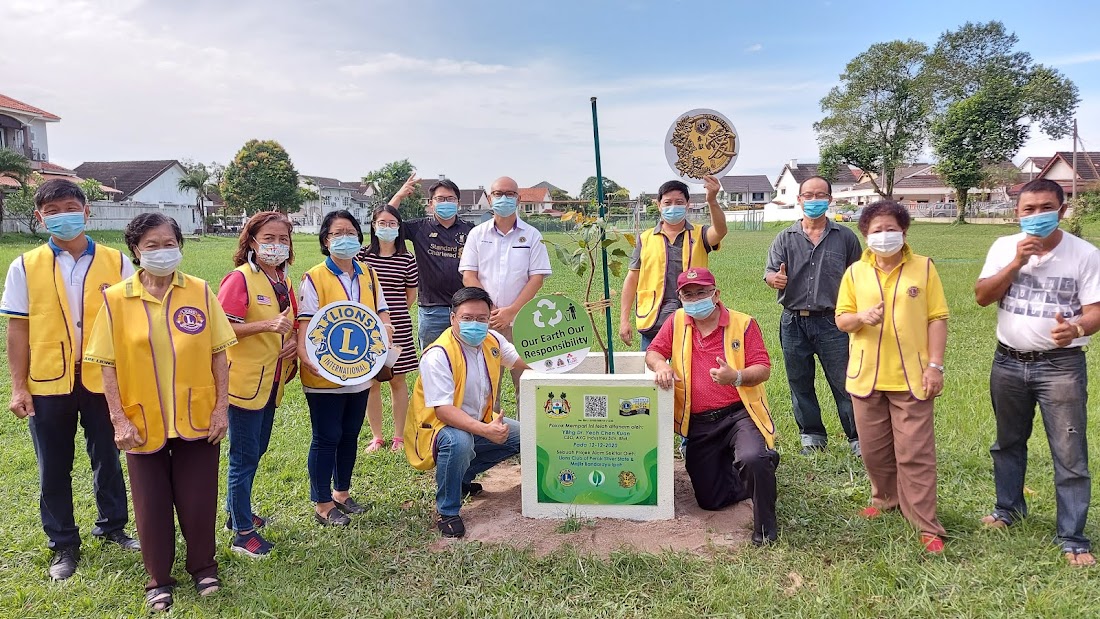In conjunction with World Earth Day 2024, Lions Club of Perak Silver State once again led a group of NGOs and Corporate Company in taking part to carry out climate action programmes on 21st April 2024 starting at 8.30am at Taman Kledang Permai Padang (opposite Loyal Academy).
Nine other NGOs and Organisations are joining in to carry out climate action programmes which include Tree Planting, Environment Talk, Eco-bricks making and managing trees already planted. Among the participating NGO and Companies include; Lions Club of Ipoh Centennial, Lions Club of Bukit Mertajam Horizon, Pantai Hospital Ipoh, Koperasi Alam Hijau Perak Berhad, Ipoh City Watch, Pertubuhan Komuniti Kepolisan Bukit Merah, Loyal Academy and Pertubuhan Rakan Komunti Pendidikan Perak.
Earth Day is an international day devoted to our planet. It draws attention to the environment and promotes conservation and sustainability.
Each year on 22 April, around 1 billion people around the world take action to raise awareness of the climate crisis and bring about behavioural change to protect the environment.
Participation in Earth Day can take many forms, including small home or classroom projects like planting a herb garden or picking up litter. People also volunteer to plant trees, join other ecological initiatives or take part in street protests about climate change and environmental degradation.
a. Planting 16 trees comprise of Ficus Elastica, Bucida, Eugenia and Tecoma
b. Tree Tagging
c. Tree Maintenance
d. Environment Talk
e. Education and Awareness
f. Eco-bricks making
g. Environment Quiz
Some of the Tree Tagging with OR code for the public to scan and obtain information about the trees planted, who planted, when planted and its carbon sequestration.
According to Wikipedia, Ficus elastica, the rubber fig, rubber bush, rubber tree, rubber plant, or Indian rubber bush, Indian rubber tree, is a species of flowering plant in the family Moraceae, native to eastern parts of South and Southeast Asia. It has become naturalized in Sri Lanka, the West Indies, and the US state of Florida. Despite its common names, it is not used in the commercial production of natural rubber.
It is a large tree in the banyan group of figs, growing to 30–40 m (100–130 ft) – rarely up to 60 m or 195 ft – tall, with a stout trunk up to 2 m (6 ft 7 in) in diameter. The trunk develops aerial and buttressing roots to anchor it in the soil and help support heavy branches.
It has broad shiny oval leaves 10–35 cm (4–14 in) long and 5–15 cm (2–6 in) broad; leaf size is largest on young plants (occasionally to 45 cm or 171⁄2 in long), much smaller on old trees (typically 10 cm or 4 in long). The leaves develop inside a sheath at the apical meristem, which grows larger as the new leaf develops. When it is mature, it unfurls and the sheath drops off the plant. Inside the new leaf, another immature leaf is waiting to develop.
2. Bucida:
A fast-growing tree that reaches between 10-20 m in height and spread to about 10-15 m wide. Its crown is layered in symmetrical tiers. The simple, unifoliate and variegated leaves are whorled along the stem. Leaves are small, measuring 2-5 cm long and 1 cm wide.
It is mottled grey-green with irregular creamy-white border, young leaves pinkish-red, margins uneven to crenate, produced in whorls at branch tips.
The twigs grow densely in storeys on whorls around the woody trunk.
Its bark is smooth, mottled pale grey, with protruding brownish streaks or spots.
Its deep anchoring roots make it able to endure high winds with little damage. Big matured tree fetch a really good price (RM>1k) in the market
The tecoma trees will grow to maximum height of 25m with carbon sequestration of approximately 7,000 kg.
Four interesting facts about 'Sakura Look-alike' Tecoma Trees that we see in Malaysia (See the following link):
Botanical Name: Syzygium myrtifolium
Full Grown Height: 6 m
Spacing: 2-5 m







